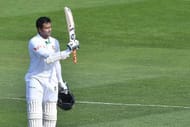Day 4 of the second Test between New Zealand and Bangladesh at Christchurch’s Hagley Oval promised to be a gritty contest. On the second day, late strikes from Shakib Al Hasan, put the visitors in a commendable position and on day 4 – with the third day washed away by rain – Bangladesh were expected to gain the all important lead and start their second innings in a confident manner with the aim to shrug off the dismal batting display during the second innings at Wellington.
But on a bright sunny day, the story of Bangladesh was another pathetic end.
Shakib Al Hasan dismissed Tim Southee, and with eight down, the hosts were still three runs away from Bangladesh’s first innings total. Neil Wagner, the thorn in the throat in the flesh of the Tigers throughout the Test series, hung on in the middle and supported Henry Nicholls to frustrate the visitors. With one hour or so, the ninth wicket stand was 83 and Bangladesh lost the edge over New Zealand.
Also Read: New Zealand complete series sweep after Bangladesh collapse
New Zealand gained a lead of 85 runs and a solid batting performance was needed from the visitors to make the contest an interesting one.
Bangladesh came out to bat and scripted the same old story of implosion. Trent Boult, Southee and Wagner applied their tactics of pitching the ball short and Wagner’s ploy to target the rib cage, yet again, unnerved the Bangladeshi batsmen. Soumya Sarkar was the only batsman who was able to negotiate the bounce for the certain period, but the rest of the batting line-up capitulated in a shambolic fashion.
The New Zealand bowlers were tough to handle on the fourth day, but what Bangladesh needed was to exhibit calm and be composed. The shot selection of the top order batsmen was kid-like. When attempting back foot stroke-play too early or playing the ball away from the body, batsmen can’t blame the conditions.
If anything had to be blamed for the implosion of Bangladesh’s capitulation then, it would be the poor mindset and lack of physical fitness to play five-day matches.
The New Zealand tour has ended in a disgraceful manner for the Tigers, but they should not lose heart and take this tour as a lesson. Bangladesh cricket needs to work on certain things for a better outcome in the near future.
Improvement of the standard of domestic cricket
It has become very important to improve the domestic infrastructure of Bangladesh cricket. The standard of domestic cricket in Bangladesh is still not up to the mark. The tracks are too flat and hardly provide any assistance for the bowlers. The sports section of Bangladesh newspapers is filled with the heroics of batsmen scoring runs heavily rather than impressive bowling feats and thus, it gives a false impression that Bangladesh are producing good willow-wielders.
But the New Zealand series has exposed the technical fragilities of Bangladesh batsmen in a harsh manner.
While playing on flat decks, a batsman doesn’t need to concentrate too much on defence and footwork and thus, he can score freely without even caring much about the technical aspects of batsmanship. The batsman thinks he doesn’t have any problem in his technique and basks in false glory.
Also Read: Bangladesh sweeps were not cakewalks, says New Zealand's Williamson
But in hostile tracks and bowling attacks, they melt down.
To overcome such problems, the wickets in the domestic cricket must be variable and should test the technique and temperament of batsmen.
If not in Dhaka, but in areas like Chittagong and Cox’s Bazar, where the breeze blowing from the sea has an impact, the tracks must be made in such a way to aid movement and bounce, and pacers should get enough assistance to make the ball talk.
Batting under such a hostile atmosphere will help develop the mental toughness and technical solidity among Bangladesh batsmen. It will make them realise that batting is not all about relying on boundaries, but occupying the crease, leaving the ball and playing it according to the merit. Playing behind the line of the ball and closer to the body, and strike rotation are vital elements of batsmanship in Test cricket.
More emphasis on the longer-version format
Even though Bangladesh struggled hard and campaigned tirelessly for the Test status, in fact, their interest in playing the best format of the game is less. Many Bangladeshi cricketers, both national-level and youngsters, focus more on improving in the shorter formats and registering their names in the teams in Bangladesh Premier League.
Twenty20 is a part of cricket and a great medium to earn cash without breaking enough sweat. Cricket has always welcomed change and there is no harm in adapting to the change which offers a sound livelihood. But too much of anything is never good and one would never like an over-cooked Biryani.
Since the rain-washed series against South Africa in 2015 to 2016, Bangladesh played just two Test matches and they even cut short a full Test series against Zimbabwe to accommodate the World Twenty20. If a team plays fewer Test matches, how is it possible to improve in five-day matches?
If Bangladesh wish to improve in Test cricket, they need to bear in mind that Test cricket is the ultimate format of the game, and concentrate on improving themselves by spending more time in the four-day domestic matches.
Improvement of physical and mental fitness
Taskin Ahmed, Subashis Roy, Kamrul Islam Rabbi or Rubel Hossain’s vim and vigour fizzled away after the first session or after bowling ten to fifteen overs. They struggled to rediscover their guile and rhythm and thus, failed to pitch the ball either up or full, and landed more on the middle and leg stump which allowed the New Zealand batsmen to settle down when they were under pressure.
Meanwhile, the batsmen failed to maintain their same fighting spirit and focus in the second innings against the barrage of short balls.
While countering the short balls, a batsman needs to do a lot of ducking, pulling and hooking which puts pressure on the muscles of the back and chest. Until and unless, a batsman’s muscles are strong and fit enough, it’s very tough to weather the storm of short-pitch bowling.
Neither can a bowler bowl consistently well if his fitness level is not up to the mark. The Bangladeshi batsmen and bowlers lacked the physical fitness to fare well in New Zealand. Against Wagner, they were apprehensive and clueless against short balls, and also looked unfit.
Cricket is a mental and technical game, but a lot of emphasis must lie in the physical fitness aspect of the game; even more so in the modern game.
Brand-new app in a brand-new avatar! Download CricRocket for fast cricket scores, rocket flicks, super notifications and much more! 🚀☄️


